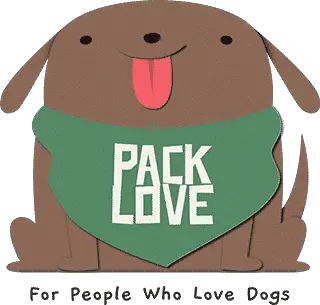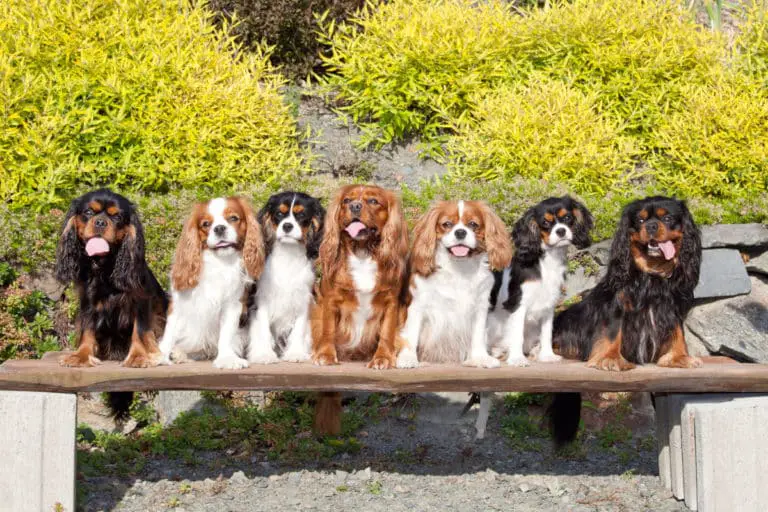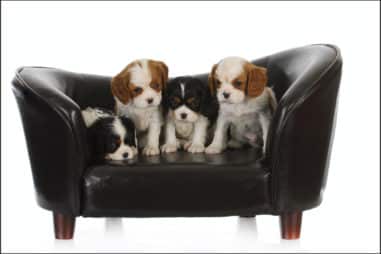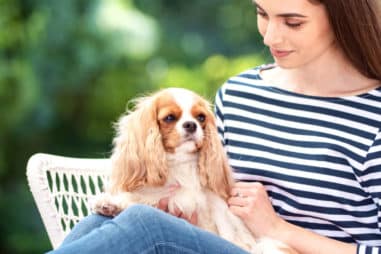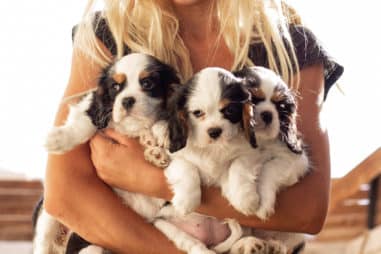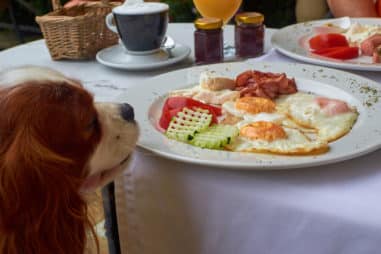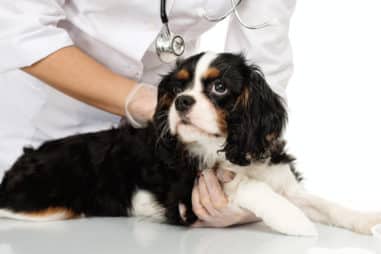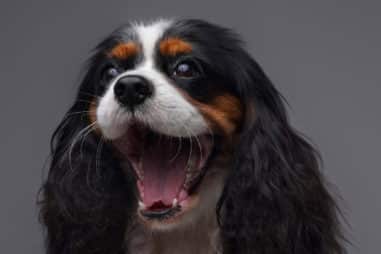Without a doubt, Cavalier King Charles Spaniels look majestic. With silky coats and long ears to frame their gentle-looking faces, they are show stoppers. They draw you further in with their large, dark eyes, making you appreciate their beauty more.
But like other dogs, there are standards for Cavaliers too. Whether you get one as a show dog or as a pet, knowing what these are will help you appreciate them more. Especially since there was a lot of work done to bring back their original looks.
What Is the Breed Standard for a Cavalier King Charles Spaniel?
When a Cavalier walks into a room, you may first notice the regal charm that they exude. Their gentle expression, due to their large and round eyes, is their hallmark.
But to get a better idea of their breed standard, you need to take a look at them as a whole. With this, here are the Cavalier King Charles Spaniel’s ideal characteristics.
Temperament
Cavaliers are friendly, carefree, gentle, and not nervous dogs.
Size
Cavaliers should have a height of 12 to 13 in (304.8 to 330.2 mm) with a weight of 13 to 18 lbs (5.9 to 8.2 kg).
Head and Skull
Their heads should be proportionate to their size, not smaller or larger than their body. While their skulls are slightly rounded, with no dome or peak. The flatness of their skull is due to their high ears.
Eyes
They have large, round, and very dark eyes. It should still be in proportion to their body, and set apart nicely. The rims of their eyes should also be dark in color.
Eyes that are too small or too large, light-colored, or almond-shaped are faults. The ring that surrounds their eyes should also not be white.
Ears
Their ears should be set high, long, and with a lot of feathers.
Mouth
Cavaliers should have a complete scissor bite. This is when their upper teeth overlap their lower teeth. Undershot bites, crooked teeth, and jaws are all faults.
Neck
Their necks should be quite long in length, with a slight arch. This arch is due to well-formed muscles at their crest.
Body
Cavaliers should have a short distance between their last rib and pelvis. They have a good spring of rib as well.
Tail
Their tails should be proportionate to their body. They must never carry it above the level of their back.
Docking is optional. But if you want to, you should not remove more than one-third of their tail.
Forequarters
Their shoulders are well laid back, with a moderate chest. Cavaliers must have straight legs with elbows close to their sides.
Hindquarters
Their legs should have moderate bones and muscles, with well-turned stifles. They should not have cow hocks or sickle hocks. A Cavalier’s legs must be parallel to each other from their hock to the heel.
Coat
Moderate-length coats that are silky. They should not have curls, but waves are allowable.
Cavaliers should have feathering on their chest, feet, and ears. The hair on their legs and tail are long. Trimming is not allowed, other than on their paw pads.
Colors
Registries only recognize the following colors:
- Black and Tan
- Ruby
- Blenheim
- Tricolor
What Is a Cavalier King Charles Spaniel a Mix of?
Breeders recreated Cavaliers from English Toy Spaniels, also known as King Charles Spaniels. This is why they look very similar, but they are two different breeds.
The reason for recreating Cavaliers is that they were gone for a while.
King Charles II loved English Toy Spaniels and was often seen with a few. They were lapdogs for royalty as well. But when Charles II died, the popularity of English Toys Spaniels diminished.
Instead, flat-faced breeds like Pugs were much favored. With this, the English Toy Spaniels were bred with those flat-faced dogs. This altered the Toy-Spaniel’s looks, losing the original traits that they had.
Roswell Eldrige, a lover of Toy Spaniels, went to England to look for the breed. Much to his surprise, the breed looked very different from what he had known. So he offered prize money to whoever could revive the original looks of the breed.
Miss Mostyn Walker was successful in this. She presented a dog to a club with the title the Cavalier King Charles Spaniel. Her dog, named Ann’s Son, set the breed standard for Cavaliers.
Are There Two Types of Cavalier King Charles Spaniels?
There is only one type of Cavaliers. But they are often confused with their cousins, King Charles Spaniels. Although they look very much alike, they are two separate breeds.
Their differences are subtle that sometimes, only a trained eye can see. But the biggest difference is in their size.
Cavalier King Charles spaniels are bigger, at 12 to 13 inches tall (304.8 to 330.2 mm) with a weight of 13 to 18 lbs (5.9 to 8.2 kg). They are one of the largest toy dog breeds there is.
While King Charles Spaniels are the smallest Spaniel breed. They stand at 10 to 11 inches (254 to 279.4 mm) with a weight of 8 to 14 lbs (3.6 to 6.4 kg).
Are Cavalier King Charles Spaniels Brachycephalic?
Cavaliers are part of the brachycephalic dog breeds. With this, they have breathing difficulties due to their short noses. Unfortunately, this means that they are also prone to health issues like overheating.
Is a Cavalier King Charles Spaniel a Snub-Nose Dog?
A lot of people seem to favor snub nose breeds like Cavalier King Charles Spaniels. Of course, they look very cute. But there are a lot of special considerations for breeds like this.
One is that they are not healthy breeds, they are prone to many medical issues. With this, airlines ban snub-nosed dogs (and cats) because it is dangerous. So if you want to travel with your Cavalier, you need to find other options to transport them.
What Are the Colors of Cavalier King Charles Spaniels?
Cavaliers have four official colors: Blenheim, Black and Tan, Tricolor, and Ruby. Some Cavaliers sport a different color to these. But colors outside of these four are not recognized by registries.
To give you a better picture, below are descriptions of these colors.
Blenheim Cavaliers
This is the most common of all the four colors. Blenheim Cavaliers have a white base color with chestnut markings.
Their muzzles are white, leading to the top of their forehead. On the sides of their head are chestnut markings, including their ears.
Some Blenheim Cavaliers have a “Blenheim Kiss” on the middle of their foreheads. This is a chestnut blot on a white background, breaking up the base color.
Black and Tan Cavaliers
These Cavaliers have a black base coat color with tan highlights. These highlights are often on their eyebrows, cheeks, inner ears, chest, legs, and under their tails. In show dogs, any white markings are a fault, but it is not an issue for pet Cavaliers.
Tricolor Cavaliers
A tricolor Cavalier has a mix of black, chestnut, and white throughout its body. The base coat color can either be black or white. Typically, the tan markings are on their eyebrows, cheeks, and under their tail.
Ruby Cavaliers
These Cavaliers have a beautiful, red-chestnut base-coat color. Some Ruby Cavaliers have white markings, while others do not.
What Is the Rarest Color for Cavalier King Charles Spaniels?
Of the four official colors, Black and Tan Cavaliers are the rarest. This is due to their complex gene combination.
When breeding for this color, there is a possibility of getting all four colors of Cavaliers. Also, some may get unwanted markings. But Black and Tan Cavaliers should only have two colors, that is the tricky part.
Does a Cavalier King Charles Spaniel Have Hair or Fur?
Your Cavalier’s silky coat is due to their hair. Compared to fur, hair is longer, smoother, and finer. This is what you see on the Cavalier’s lustrous coat.
Because of this, they are moderate shedders. Cavaliers shed less during spring and fall compared to other breeds. But this can still be much for some people.
What Type of Coat Does a Cavalier King Charles Spaniel Have?
Cavaliers have smooth medium-length coats that can be straight or slightly wavy. They have beautiful, long feathering on their chest, ears, tail, and legs. A notable feature of theirs is their fluffy feet, as hair here grows quite long too.
They are not hypoallergenic dogs, as they shed quite a bit. But they are not as high maintenance as other toy breeds. With Cavaliers, they need daily brushing to maintain their luxurious, tangle-free coats.
Are Cavalier King Charles Spaniels Double Coated?
This is tricky, as various sources have conflicting answers to this. Some say Cavaliers have double coats, while others say they have single coats. But, it could be that your Cavalier may not fit into both.
To start, it is important to define both terms.
Double-coated dogs have an undercoat and topcoat, varying in length. The wool-like undercoat serves as insulation, keeping them cool or warm when needed. While the topcoat protects them from water and dirt.
Single-coated dogs do not have these two layers. But an advantage of this is that they do not shed much.
So where does your Cavalier fit into? A better category for this breed may be different. Instead of being double-coated, Cavaliers are combination-coat dogs.
Combination coats have two “layers” as well. A long, silky coat and a shorter, smooth coat. The smooth coat is what you find in many dogs, like the Frenchie. Their coat is short and has no texture, but can shed a lot.
A Cavalier’s smooth coat may not look like the typical undercoat in double-coated dogs. But you can argue that they have two coats too. So this is where the confusion begins.
The AKC recognizes Cavalier King Charles Spaniels as not having a double coat. But many sources and Cavalier owners say that this breed does.
If you want to find out what coat your Cavalier has, it is best to check this yourself. Or, you can ask experts, like your vet, to help you with this.
Do Cavalier King Charles Spaniels Have an Undercoat?
The lustrous coats of Cavaliers do have a smooth undercoat. With this, they do shed all year round, which requires daily brushing. You can also rake your Cavalier’s undercoat to help keep them cool during warmer months.
When Do Cavalier King Charles Spaniels Get Their Full Coat?
The permanent coats of Cavaliers will grow out completely when they are around one to two years of age. All dogs are not born with their full coat, and your Cavalier is no exception.
While waiting for them to grow their beautiful coat, they will get the “puppy uglies”. During this period, shed their puppy coat, almost like their hair is gone. But they are still too young to grow their adult hair, so they do not look their best.
It is typical for their coat to grow at different rates during this stage. This gives them an unbalanced look.
This is nothing to worry about, even show-dog Cavaliers go through this stage. Keep in mind that this is temporary, so you have to wait a bit for them to bloom!
Why Do Cavalier King Charles Spaniels Have Long Ears?
Your Cavalier’s long ears have a practical purpose. It helps to protect their middle and inner ears from external factors, such as dirt. But this feature has a bigger purpose in their other Spaniel cousins.
As part of the Spaniel family, Cavaliers also have long, floppy ears. Spaniels have two distinguishing features: their long, silky coat and their long ears. So your Cavalier’s ears may look longer due to the length of the hairs on their ear.
Long ears give them a huge advantage. They use their ears to guide scents toward their noses to hunt for prey. But this is for hunting Spaniels who have a high prey drive. Instead, Cavaliers are lap dogs with lower prey drives in comparison. So they may not use their ears for this purpose.
Is a Cavalier King Charles Spaniel a Small or Medium Dog?
With a height of 12 to 13 in (304.8 to 330.2 mm), Cavaliers are small dogs. But they are one of the largest toy breeds that you can find too. Affectionate and playful, they are wonderful lapdogs with natural athleticism.
Are There Different Sizes of Cavalier King Charles Spaniels?
There is only one official size for Cavaliers, the standard one. You may confuse Cavaliers with the English Toy Spaniel, also known as the King Charles Spaniels. The latter is a smaller dog, but this is a separate breed from Cavaliers.
Is There a Mini Cavalier King Charles Spaniel?
There are mini or teacup Cavaliers, but they are not an official size. These smaller versions of Cavaliers are often bred irresponsibly. Their breeders often only take size into account, not their health or behavior.
With this, you should avoid buying teacup or mini Cavaliers. Not only are they very expensive, but you may also spend more on their vet costs as they are often unhealthy.
Also, this is not an ethical choice. It gives their breeders more reason to keep producing mini Cavaliers, which is cruel.
Are There Toy Cavalier King Charles Spaniels?
If you are looking for a toy dog, Cavaliers are a popular choice. They are sturdy, playful, and athletic, enjoying hikes and dog sports. But they are also loving and friendly, making them great lapdogs and family dogs.
Do Cavalier King Charles Spaniels Stay Small or Grow Big?
Cavaliers are born very small and continue to grow until they are about 9 to 10 months of age. They will remain this small over their lifespan. Small dogs like Cavaliers reach their final height much quicker than larger dogs.
How Big Do Cavalier King Charles Spaniels Get?
Your lovely Cavalier does not grow very big, their final height is only 12 to 13 in (304.8 to 330.2 mm). They are also not heavy dogs, only weighing about 13 to 18 lbs (5.9 to 8.2 kg). Of course, they can get overweight, so you should keep them active to maintain their ideal weight.
How Quickly Do Cavalier King Charles Spaniels Grow?
As a small breed, Cavaliers grow fast, within a year. On average, they grow their final height at about 9 to 10 months. But they continue to fill out until they are around 12 to 15 months old.
At What Age Are Cavalier King Charles Spaniels Fully Grown?
Cavaliers have their adult height at 9 to 10 months, but they are full-grown when they are about 1 to 2 years old. After 10 months, they gain more weight and girth, leading up to their adult size as a whole. But they do not grow taller after this.
How Big Is a Full-Grown Cavalier King Charles Spaniel?
Once they reach their adult size, you can expect your Cavalier to be somewhere between 12 to 13 in (304.8 to 330.2 mm) in height. Female Cavaliers have a smaller build and are lighter, while males are larger and heavier.
How Big Do Mini Cavalier King Charles Spaniels Get?
Mini or teacup Cavaliers are much smaller, only about 5 to 10 in (127 to 254 mm) tall. They also weigh less than 10 lbs (4.5 kg). So there is a significant physical difference between them and standard-sized Cavaliers.
How Much Do Cavalier King Charles Spaniels Weigh?
The weight range for Cavaliers is 13 to 18 lbs (5.9 to 8.2 kg). Unfortunately, this wonderful breed is prone to obesity. They love to eat like kings and some genetic conditions can worsen this.
An overweight Cavalier has a shorter life span. They have more stress on their joints and hearts, making them prone to injuries. It does not help that they have a genetic predisposition to heart issues.
So as part of caring for your Cavalier, keep them at a healthy weight range. Use their natural athleticism to your advantage, they love playing and running around.
How Much Should a Cavalier King Charles Spaniel Weigh?
A female Cavalier is lighter, at around 10 to 18 lbs (4.5 to 8.2 kg). While a male Cavalier is heavier, at about 13 to 18 lbs (5.9 to 8.2 kg).
How Much Should a Cavalier King Charles Spaniel Puppy Weigh?
At the age of 3 months, Cavalier puppies are ready for adoption, weighing 5.7 to 7.9 lbs (2.6 to 3.6 kg). Keeping a watch on your puppy’s weight as they grow will help you ensure their health. With this, here is the list of your Cavalier’s ideal weight by month of age:
- 3 Months of Age:7 to 7.9 lbs (2.6 to 3.6 kg)
- 4 Months of Age:6 to 10.3 lbs (3.4 to 4.6 kg)
- 5 Months of Age:2 to 12.8 lbs (4.1 to 5.8 kg)
- 6 Months of Age:3 to 14.1 lbs (4.7 to 6.4 kg)
- 7 Months of Age:4 to 15.6 lbs (5.1 to 7.0 kg)
- 8 Months of Age:0 to 16.5 lbs (5.4 to 7.4 kg)
- 9 Months of Age:3 to 17.1 lbs (5.5 to 7.7 kg)
- 10 Months of Age:6 to 17.5 lbs (5.7 to 7.9 kg)
- 11 Months of Age:8 to 17.9 lbs (5.8 to 8.1 kg)
- 12 Months of Age:0 to 18.1 lbs (5.9 to 8.2 kg)
How Much Should a 6-Month-Old Cavalier King Charles Spaniel Weight?
Cavalier puppies weigh around 10.3 to 14.1 lbs (4.7 to 6.4 kg) at 6 months of age. Smaller ones, typically females, are on the lighter end of this range. While larger ones, which are usually males, are on the heavier end.
What Is the Ideal Weight for a Cavalier King Charles Spaniel?
The healthy weight range for a full-grown Cavalier is between 13 to 18 lbs (5.9 to 8.2 kg). Once they are adults, it is important to keep them in this range to avoid health issues. With a dog that loves to eat, this means that you should help them control their eating habits.
Why Is My Cavalier King Charles Spaniel So Small?
Some Cavaliers are daintier, slighter in build than others. With puppies, they grow at different speeds. Others may lag behind their litter, catching up on their growth later on.
Other Cavaliers are small right off the bat compared to their brothers and sisters. So your Cavalier may be the runt of the litter, which explains their size.
All these explanations are for standard Cavaliers. If you have a teacup Cavalier, they are much smaller than usual, as breeders intend them to be.
If your Cavalier’s size concerns you, take them to the vet. This can be a sign that they have health issues, making them look smaller. But if they get a clean bill of health from your vet, this is nothing to worry about.
What Is the Smallest Cavalier King Charles Spaniel?
The smallest full-grown Cavalier by standards should be 12 in (304.8 mm) in height and 10 lbs (4.5 kg). There are outliers to this, which are mini or teacups Cavaliers who are smaller and lighter. But they are not recognized by registries and are often bred unethically.
Other outliers, like Nessa, are small because they are the runt of the litter. Nessa is a Cavalier who only weighs 7 lbs (3.2 kg), much lighter than the standard.
Why Is My Cavalier King Charles Spaniel So Big?
If your Cavalier looks like they are on the chunkier side, it can be an issue with its weight or coat. Their size can be dangerous, so figuring out the root cause is important. To help you out, below are the common reasons why your Cavalier got bigger.
Overfeeding
Overindulging your Cavalier with food is not good for managing their weight. You should stick to the recommended feeding portions by your vet. This is the most common reason for Cavaliers getting overweight.
Inactivity
Your Cavalier needs to use the calories that they get from eating. As indoor dogs, Cavaliers may not get enough exercise, making them gain weight.
This breed is quite energetic, so they need a release. Let them play or run outside, or you can even take them out for walks. Daily activity is crucial in keeping their weight down.
Genetics
Cavaliers are one of the many dog breeds that are prone to obesity due to genetics. So any lapses in maintaining their weight can quickly affect their bodies.
Health Issues
Certain disorders, such as hypothyroidism, can contribute to your Cavalier’s weight gain. A visit to the vet can rule out this possibility. They can also help you pinpoint the cause of their excess weight if their health is not the issue.
Medications
If your Cavalier needs to take medication, a side effect of some is a greater appetite. Phenobarbital, used for seizures, is one of these.
Matting or Tangles
This breed can be high maintenance, as they need daily brushing. Neglect this and you will get an unhappy, matted Cavalier.
These clumps make them bigger than they are. If your Cavalier still looks chunky despite proper diet and exercise, this may be the reason.
Neutering or Spaying
These surgeries alter your Cavalier’s hormone levels. This can cause their bodies to spend more energy, increasing their hunger. So they eat more, causing excess weight.
How Big Is the Biggest Cavalier King Charles Spaniel?
The biggest Cavaliers are 13 in tall (330.2 mm) and weigh 18 lbs (8.2 kg). Maintaining their weight up to this is essential in keeping them healthy.
Otherwise, the excess weight will put so much stress on your Cavalier’s joints. This will cause them mobility issues, lowering their quality of life. Other than that, being obese makes them susceptible to many health issues.
Where Are Cavalier King Charles Spaniels From?
Cavaliers are from the United Kingdom and were a popular companion for the royals. This affectionate breed were “comforters”, used as toy dogs and warmers.
But it was Charles I and Charles II that made Cavaliers popular among the nobles. The latter always had Cavaliers by his side to go with him on his daily activities.
What Are Cavalier King Charles Spaniels Bred for?
In the past, Cavaliers were lap warmers to the nobles. But today, they are gentle companions for many people. As a toy dog, your Cavalier is more than happy to run errands or go on a hike with you and more.
They are also natural athletes, great in dog sports like agility and rally. Some can even be hunting dogs, being such close relatives to other hunting Spaniels.
With their affectionate and gentle nature, Cavaliers excel at being family dogs too. They do well with kids and older children and love playtime with their little humans.
Are Cavalier King Charles Spaniels Hunting Dogs?
Although they are not made to be one, Cavaliers can be great hunting dogs. They need training for this though, but with their traits, you have a good start. Five factors make Cavaliers good hunting dogs, all listed below.
They Are Athletic
Cavaliers have high energy levels that make it okay for them to run around for a few hours. This is why they have no problem going with you on hikes, running on beaches, etc.
Running around is one of their favorite activities. And with a hunting dog, this is essential to catch prey.
Their Prey Drive
Hunting dogs need a strong prey drive, which a Cavalier has. They like to chase rodents and small animals outdoors, which many pet owners do not like. But for hunting, this is a huge advantage.
They Are Smart
This breed ranks 44th in The Intelligence of Dogs by Stanley Coren. Ranking as high average, this breed is more than capable of learning a variety of commands. They can also respond well to training, especially for obedience.
Their History
Cavaliers have hunted in the past. They hunted small animals and waterfowl in bushes and lakes. Although they are lap dogs now, their hunting instincts are still intact.
Their Personality
As great companions, Cavaliers are willing to engage in activities that involve you. They can learn to like hunting, as long as it pleases you. This is the cherry on top of making them great hunting dogs.
